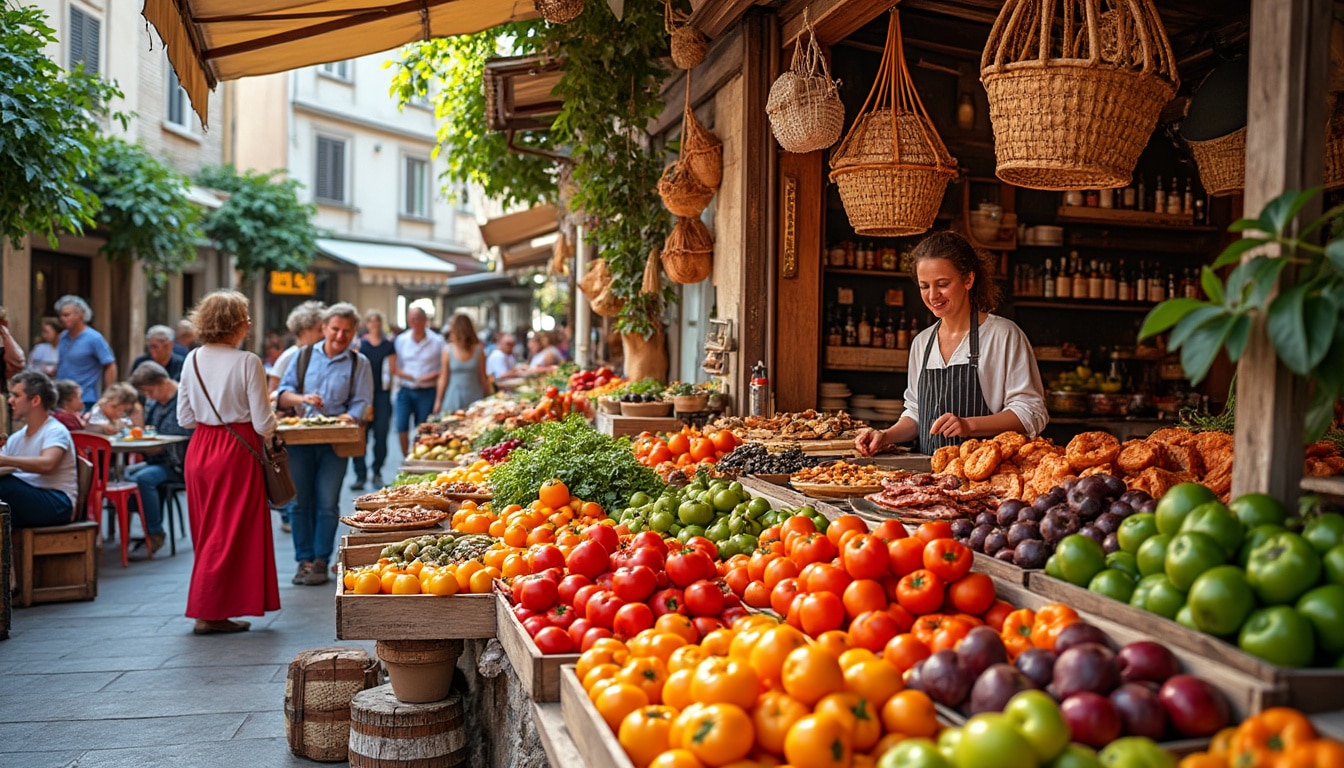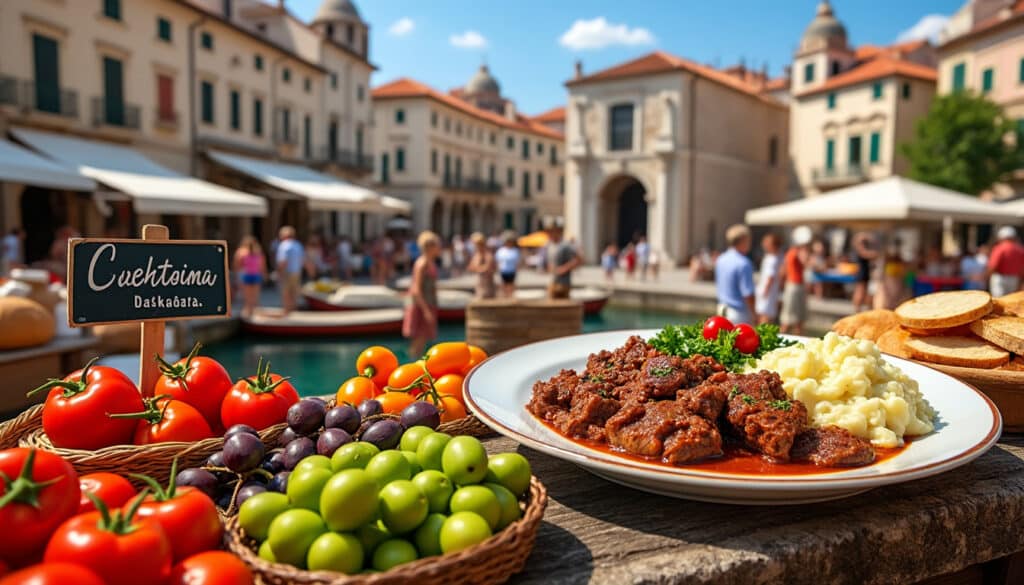Split, the vibrant heart of Dalmatia, is as much about absorbing its ancient history and azure coastline as it is about indulging in its diverse culinary scene. This Croatian city, known for its intriguing blend of Balkan and Mediterranean influences, offers a gastronomic journey that is as rich and varied as its cultural tapestry. From iconic dishes like pasticada and black risotto to the leisurely coffee culture and bustling konobas, Split’s menu is as colorful as its landscape. Understanding what locals eat here offers visitors a glimpse into their way of life, driven by tradition, community, and an enviable seaside lifestyle. Whether you’re a fan of seafood, a meat lover, or intrigued by vegetarian delights, Split promises to satiate all palates with its authentic Dalmatian fare.
Dalmatian Cuisine: The Core of Split’s Culinary Experience
Dalmatian cuisine forms the backbone of what people eat in Split, rooted in a tradition that boasts fresh ingredients, a wealth of seafood, generous use of olive oil, and aromatic herbs. This coastal gastronomy is heavily influenced by the Mediterranean diet, acclaimed for its health benefits and flavors. Here, dishes tend to be straightforward but never simple in taste, celebrating the quality of ingredients rather than complexity.
A visit to Split would be incomplete without trying some of its seafood delights. Grilled fish, known as “na gradele”, is commonly served Mediterranean-style with a splash of olive oil, garlic, and parsley – a simple yet mouthwatering dish that shows the freshness of the catch. For a heartier fare, fish is often cooked in a stew known as “brudet”, a slow-cooked medley of fish, tomatoes, and spices that varies by household but always evokes a homey warmth.
- 🦑 Buzara: This dish features shellfish cooked in a savory and slightly spicy sauce of garlic, parsley, and wine.
- 🐟 Brudet: A fish stew made with a variety of seafood, tomatoes, onions, and wine.
- 🥩 Pašticada: A sweet-and-sour beef stew, marinated in wine and spices, then cooked slowly for hours, typically served with homemade gnocchi.
- 🐷 Dalmatian Prosciutto: A smoked and dried ham, often served as an appetizer with local cheese and olives.
Split is also famous for its unique preparation methods like the iron lid peka. Often reserved for special occasions, this involves cooking meat, fish, or octopus with potatoes under a bell-shaped lid covered in embers, allowing the ingredients to slow-cook in their own juices for a melt-in-the-mouth experience.
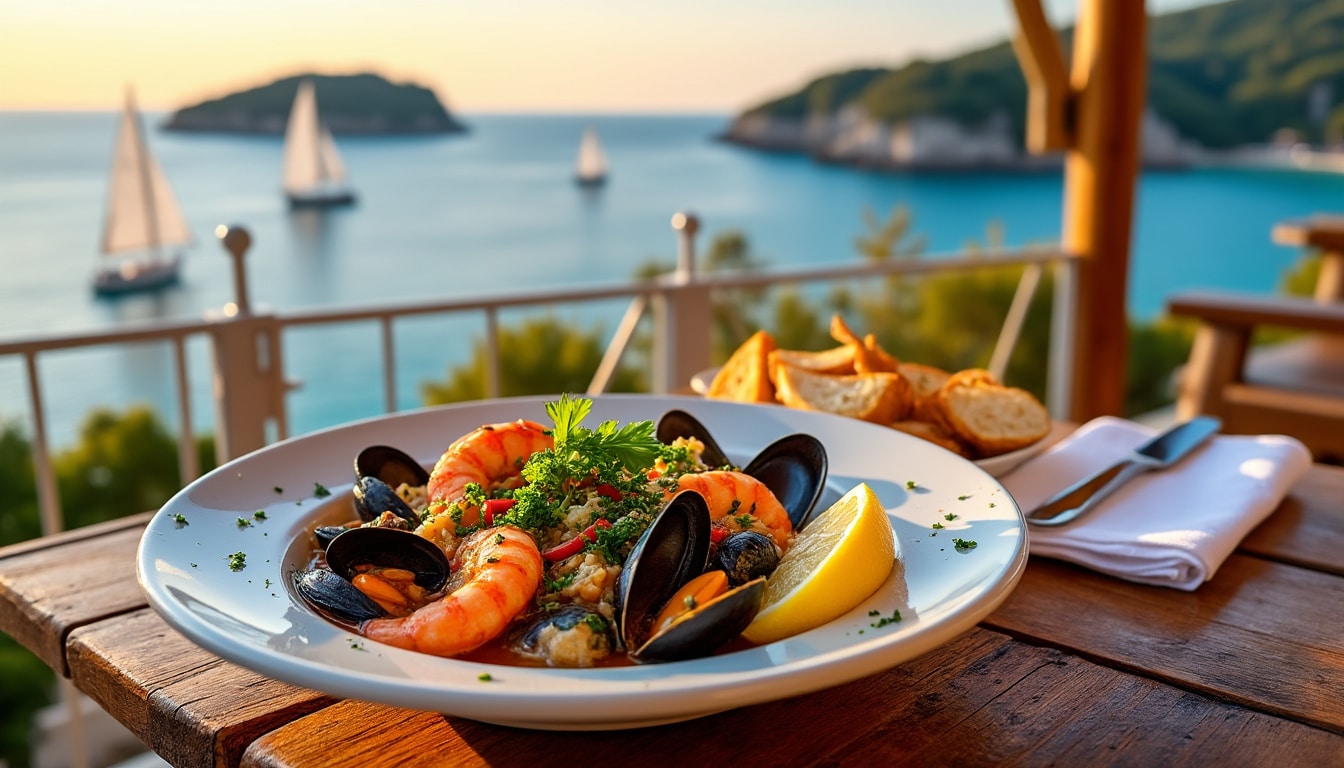
Beyond specific dishes, the way meals are enjoyed in Split is just as significant. It’s common to see locals taking long, languid meals, enjoying the act of eating as a communal and social event. This leisurely approach is especially prominent during grand dinners, where meals might start with tapas-like plates of olives, cheese, and cured meats and flow into main courses accompanied by local wines, capping with desserts like the enticing Vis hib, a fig pie.
The Influence of Mediterranean Techniques
The Mediterranean influence in Split’s cuisine is profound. Olive oil, a staple of the region, is used profusely, imbuing dishes with its rich, fruity flavor. This is no surprise, considering the olive groves that dot the Dalmatian landscape, offering fresh, locally-produced oil that elevates every meal.
- 🥗 Olive Oil: Integral to salads, dressings, and used generously while cooking grilled vegetables and fish.
- 🥖 Bread: Served at almost every meal, commonly baked daily in small batches in traditional stone ovens.
- 🌿 Herbs: Basil, rosemary, and parsley are frequently used, bringing out the subtle flavors of dishes.
This deep connection with the land can be tasted in every exquisite bite of Dalmatian food in Split.
Culinary Diversity in Split: From Local Taverns to Fine Dining
While Dalmatian dishes are central to Split’s cuisine, the city offers much more. Its status as a bustling port and major touristic area means a wide array of options retailoring dishes from different parts of the world, reimagined with a local flair. Split’s culinary diversity can be tasted in its eclectic array of eateries, from homely konobas to upscale restaurants, each presenting a fresh take on conventional recipes.
The Konoba, a traditional Croatian tavern, is where one can experience the heart of Split. Here, the menus are often tightly focused on regional dishes with a rustic edge, offering a taste of home cooking in an inviting setting. For instance, in konobas, the marenda is a must-try, a midday feast akin to brunch, featuring cured meats, cheese, and often a hot dish like frittata or hearty soup.
On the higher end, Split presents some notable fine-dining experiences that reinterpret Mediterranean classics with inventive twists. Enticing options include the romantic Restaurant Dvor, known for its modern takes on traditional recipes, set in a picturesque sea-facing venue. Another gem is Bistro Bura, which deftly combines Dalmatian cuisine with contemporary culinary trends, offering dishes like Adriatic squid ink risotto.
If a delightful pizza is your quest, Pizzeria Galija crafts pizzas with locally sourced ingredients, capturing the imaginations of patrons with traditional specialties and innovative toppings.
Unexpected Culinary Surprises
For visitors seeking a connection with local life and an authentic culinary exploration, the lively Villa Spiza cannot be overlooked. Here, the dynamic menu is based around whatever the daily market can provide, ensuring every bite bursts with freshness and flavor.
- 🍤 Market Fresh Ingredients: Everything is prepared using fresh produce from the market each day.
- 📜 Dynamic Menu: The offerings change daily, depending on the ingredients available, creating unique experiences every visit.
- 🍲 Croatian Soul Food: Tuck into hearty, comforting dishes inspired by generations-old recipes.
Beyond restaurants, Split’s eateries cater to a variety of palates with ethnic options drawing influence from Bosnia, Turkey, Italy, and Greece.
Experiencing Split’s Meal Times and Traditions
Understanding local customs around meal times offers unique insights into the culture, allowing visitors to partake in a broader culinary journey. Meal times in Split vary significantly from what many might be accustomed to, driven by traditional methods and influenced by climate.
Breakfast and Coffee Rituals
Split’s day begins early with a light breakfast, usually consisting of pastries and eggs. Morning meals are often accompanied by a staple of Split’s daily rhythm – coffee. The love for coffee here transcends mere consumption; it’s an event, an exercise in patience and social immersion. Locals are seen leisurely savoring their cups, often taking time to people-watch and chat, extending their stay in the cafe well into the morning. Alongside coffee, a shot of local brandy might also make an appearance, a custom in these parts.
- 🥐 Light pastries and eggs
- ☕ Coffee, often enjoyed slowly
- 🥃 Sometimes accompanied by local brandy
Lunch and Midday Breaks
Lunches are savored beginning around midday with marenda, a meal that features homestyle dishes, and continues into the afternoon. Local konobas serve these meals until early afternoon. The pace quickens with the desire to enjoy the rest of the sunny day, making lunch a less drawn-out affair compared to dinner.
Evening Feasts
Dinner, however, is the grand event. Generally starting around 8 PM, feasting is encouraged with various courses. Due to the cool evenings following a typically hot day, dining outside is pleasurable and common. This is when creativity in dishes comes alive; it’s the meal where both culinary skill and the art of dining converge. Particularly in summer, dinner involves not just eating but enjoying Split’s cultural ambiance including the gentle sound of the Adriatic lulling in the background.
- 🌆 Begins late, usually at 8 PM
- 🥗 A variety of courses
- 🍷 Often includes local wines
- 🏝️ Outside dining is popular in warm-weather months
These dining customs amplify the traditional concept of food as not just sustenance, but art and lifestyle.
Paying, Tipping, and Dining Etiquette
Dining in Split comes with its own set of etiquettes, reflecting the warmth and hospitality of the culture. With cash almost a necessity in local markets, most restaurants and cafes widely accept cards. Famous foods in Split are often enjoyed in konobas, where visitors can expect the host to sometimes offer a drink on the house, a delightful gesture extending friendship across cultures.
Tipping Practices
In Croatia, tips are typically modest. While not required, rounding up the bill or leaving a small tip is appreciated in local eateries. Fine dining establishments may include a service charge, but tipping a bit extra showcases appreciation for exceptional service.
- 🪙 Rounding up the bill is the norm
- 🍽️ No tip expected in small eateries
- 🎩 Extra tip appreciated in upscale restaurants
Paying respects to local customs during meals ensures a pleasant experience, bridging language and cultural gaps with the universal love for good food.
Understanding Split’s dynamic and diverse culinary landscape helps visitors fully embrace the region’s essence, mixing historic charm with modern-day creativity. As you step into the city’s konobas, fine diners, and eclectic eateries, remember that each plate tells the story of its past, intertwined with the people who enjoy making and sharing these meals every day. For those bitten by the travel bug, Split’s gastronomic journey is an unmissable part of Croatian travel, beckoning with the allure of its coastal delights and unique traditions.
FAQ: Experiencing Food in Split
| Question | Answer |
|---|---|
| What is a must-try traditional dish in Split? | The iconic Pašticada and black risotto are traditional dishes you shouldn’t miss. |
| What is the best time to have dinner in Split? | Dinner is typically enjoyed late in Split, around 8 PM, when the evening cools down, especially in summer. |
| Are credit cards accepted in Split? | Yes, most restaurants and cafes accept credit cards, though it’s wise to have cash for local markets. |
| What is the local tipping custom? | Tipping is generally modest, with rounding up or small tips appreciated, particularly in fine dining settings. |
| Where can I find a good konoba to try local Croatian dishes? | Local favorites include KONOBAs such as Taverna Riva and Restaurant Fife, known for their traditional menus. |
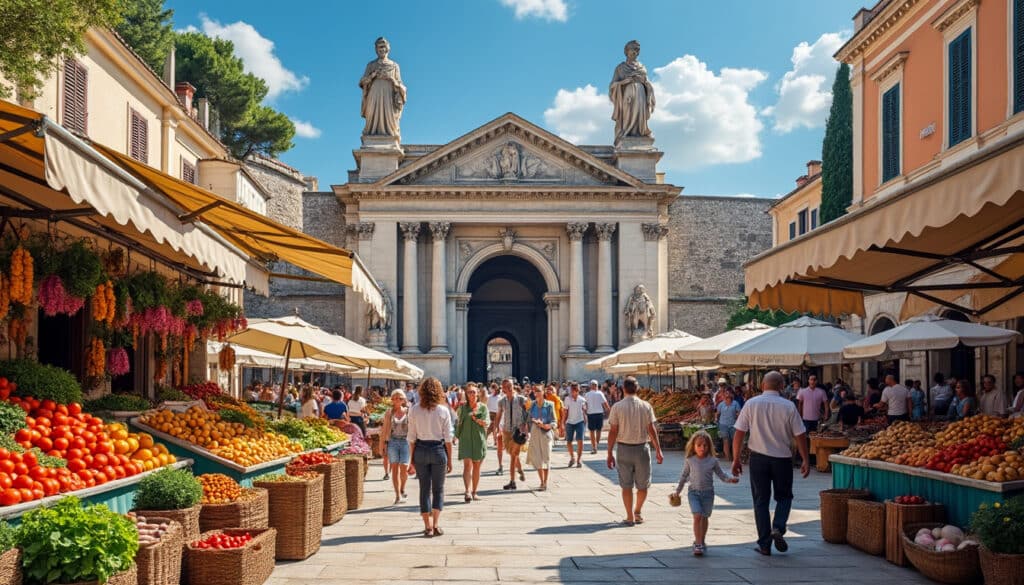
On the Dalmatian coast, the ancient city of Split stands as a testament to the harmonious blend of history, culture, and contemporary life. With streets paved centuries ago, meandering through narrow passages leading to sunlit plazas and ancient towers, Split…
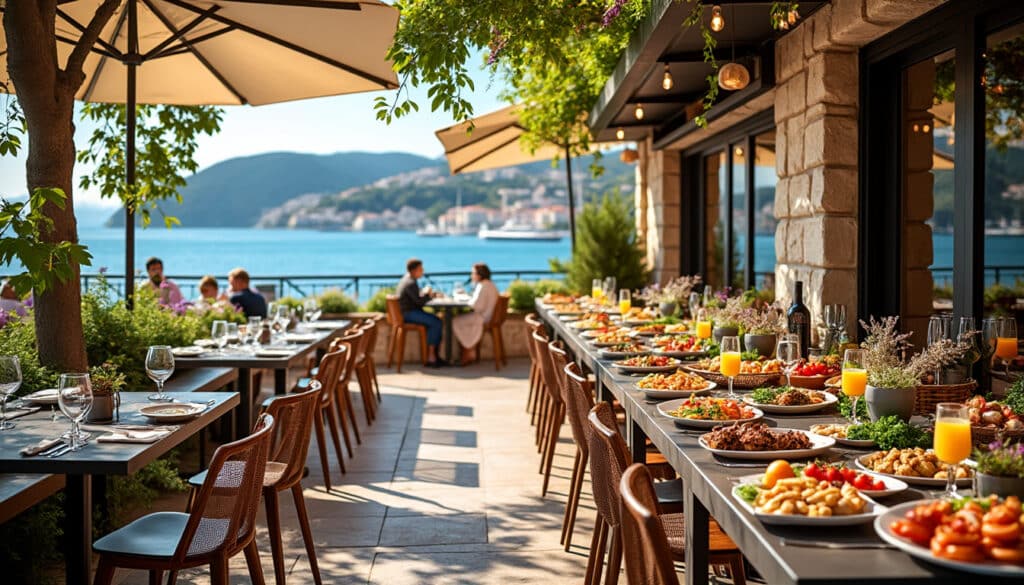
In the radiant heart of Split, where ancient history meets vibrant local life, the culinary scene offers a delectable tapestry of both traditional and contemporary flavors. From quaint konobas to avant-garde eateries, dining in Split is an experience that captures…
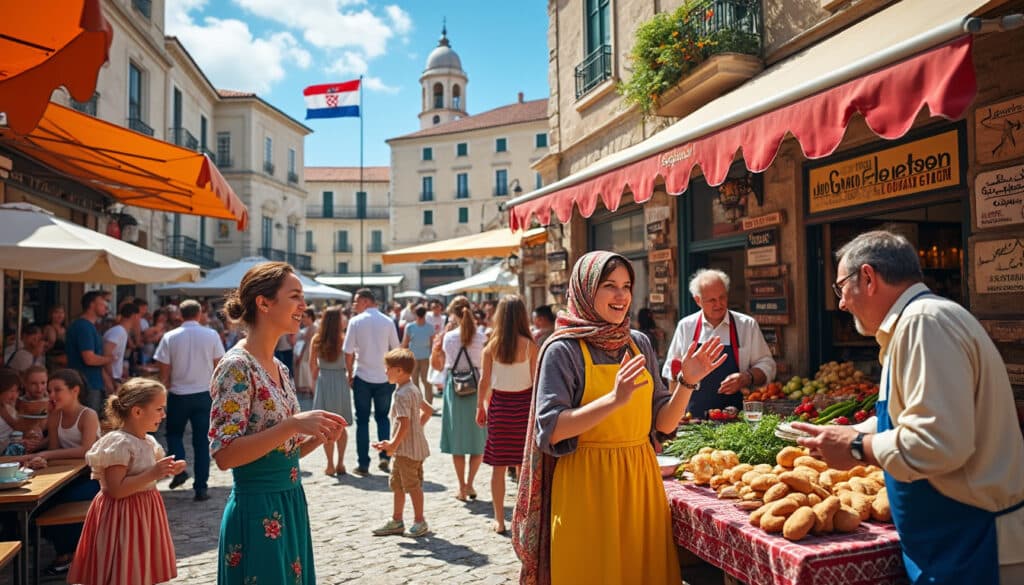
Split, a picturesque city nestled along the Adriatic coast, is a melting pot of languages and cultures. The linguistic landscape in Split is as dynamic and diverse as the city itself, characterized by the rich historical tapestry of the region.…
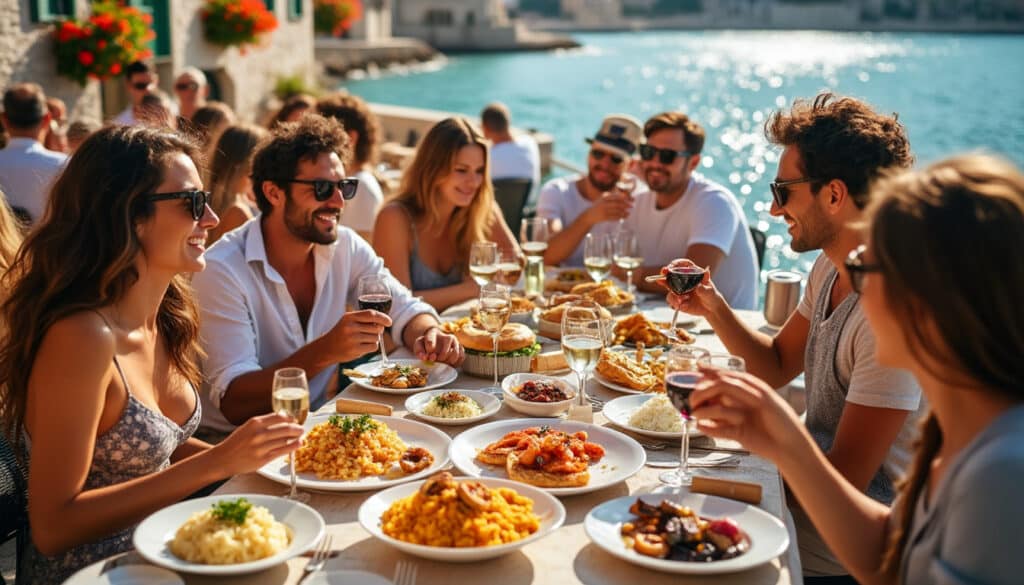
In the vibrant streets of Split, Croatia, meal times are more than just moments to satisfy hunger; they are cherished occasions that intertwine the city’s rich history and diverse cultural influences. This coastal gem, nestled along the Adriatic Sea, boasts…
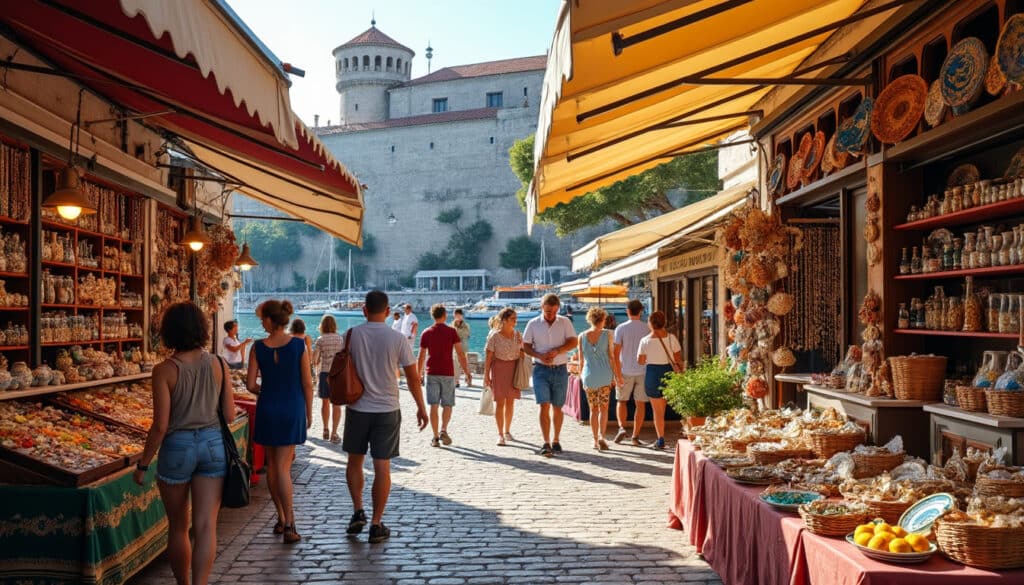
Souvenirs and shopping in Split
Shopping in Split is an enticing blend of tradition and modernity, where the past and present harmoniously coexist to offer a variety of experiences for locals and tourists alike. Split, Croatia’s bustling coastal city, is not just about its stunning…

